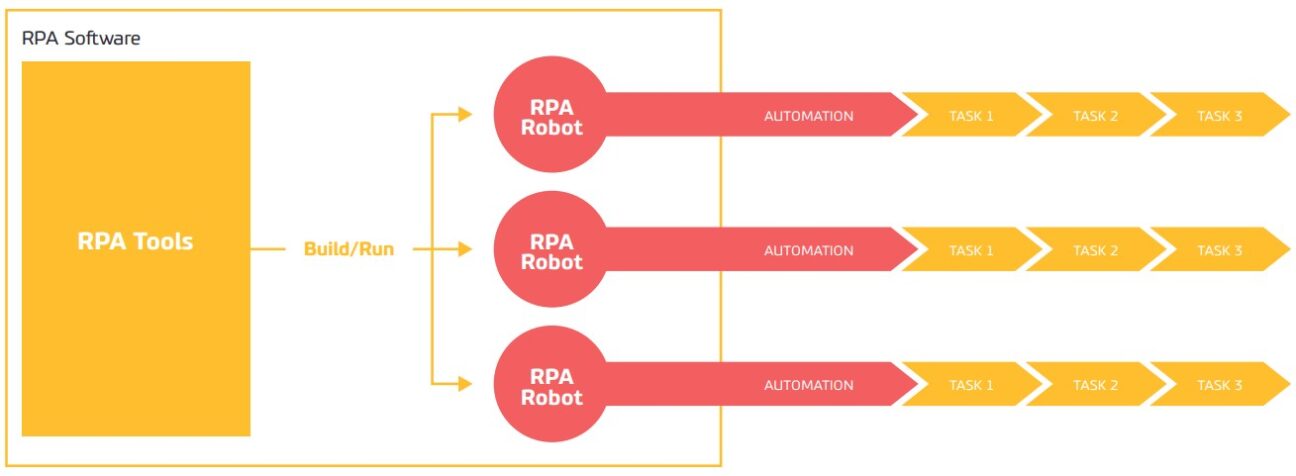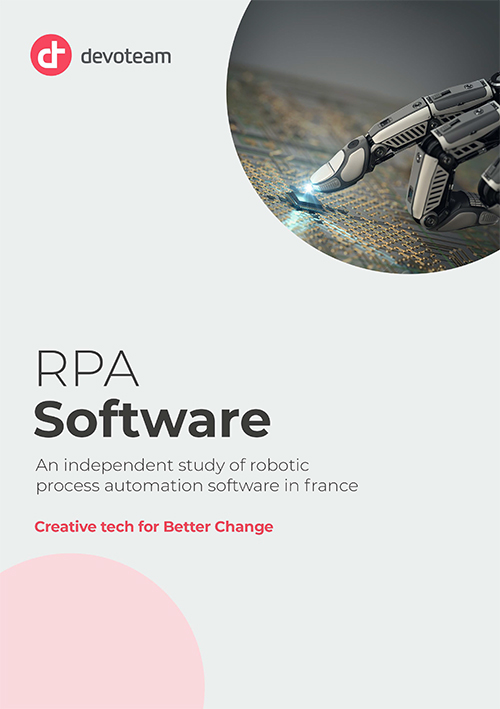Software for Robotic Process Automation (RPA) has established itself as a new category in the software market. As always with new categories, it is broadly discussed, with many definitions, opinions, and some confusion regarding what it entails.
Nevertheless, the RPA suppliers generally present the benefits of RPA as being immense and the approach is considered simple and convenient.
So, is software for RPA just the latest hype or is it really “the new thing” in which businesses should engage?
Many suppliers are engaging in RPA in the pursuit of new market opportunities. The global market expectation is projected to be approximately 8 BUSD by 2025, giving an average annual growth rate of approximately 800 MUSD for RPA software and RPA consulting services over the coming 10 years, with a 1:1 split between software and consulting services. This shows that RPA will be a significant new value generator for the software and service suppliers over the next few years.
One of the interesting aspects of RPA is that literally all industries are still using human labour to perform high volume, repeatable administrative tasks. These tasks are precisely the focus of RPA. By deploying RPA software, any company is capable of building RPA robots to replace human labour for the tasks through their automation.
There are many varieties of RPA software. The capabilities and features of the technologies vary considerably, and the strengths and weaknesses often depend on the business context in which the software is to be implemented.
The objective of this report is to offer an introduction to the relevance of RPA on the market by looking into key issues such as RPA features, where to apply RPA, possible business benefits to achieve and known pitfalls to avoid. Furthermore, a line of current RPA software is introduced and assessed and a way to get started with RPA is outlined.
Case: Insurance, Customer Risk Profiles
Insurance companies often use RPA to calculate customer risk profiles and insurance offers based on data from multiple sources.
Typically, the customer enters their data into a form on the supplier’s website, in some cases these forms are filled out in dialogue with an insurance officer.
Using these data, an RPA robot extracts relevant information for the insurance calculation from other systems. This could be data from the official motor registry regarding the specific data of a car such as weight, type of engine, age, etc. Regarding insurance on houses and belongings, data are often extracted from the buildings and housing register on the size of the house, year, and any other available details. Using the available data, the RPA robot calculates risks and a price for the customer.
The RPA robot ensures that the customer receives a prompt response to a pricing request and that the company extends offers to as many potential clients as possible, while ensuring compliance with the company’s risk strategy and policies.
Case: Transportation, Order Uptake and Fulfilment
A major global transport provider has used RPA to automate the order uptake and fulfilment for the majority of the providers’ freight orders.
The company originally implemented a manually controlled rule-based RPA solution to augment/ replace the manual order uptake and fulfilment.
Due to large periodic variations of workload as well as spikes caused by global and business events, it was hard to perform efficient capacity management and run control. This was conducted manually, causing a number of inefficiencies to manifest.
The IT solutions and platform provider was therefore contracted to re-architect the RPA solution to be a highly scalable Cloud-hosted solution.
The main business driver for the rearchitected solution was a higher degree of automation giving fewer errors, cost savings by abandoning on-premise solutions and manual labour, a very high degree of scalability and a very high degree of business continuity due to global failover possibilities.
The ensuing solution is hosted in Azure using the smallest and cheapest virtual machines for worker nodes and re-architected in such a way that the original maintainers can work and understand the code. It fully automates workload prediction in order to comission or decommission worker nodes in increments of 10s, 100s or 1,000s as needed. Failed or crashed worked nodes are placed in an error queue for manual intervention.

WHAT DEFINES RPA?
The term ‘Robotic Process Automating’ sounds full of promise. In reality, RPA is, however, much narrower in its application than suggested by the term itself.
A typical scenario for RPA is shown in figure 1. The pre-RPA scenario is that an employee performs a certain repeatable business process by using different systems and/or interfaces. This can be a time-consuming procedure, as the user typically must log onto several systems, wait for the response time to continue, change interface repeatedly, and so on.
Using RPA software, the employee is replaced by a RPA robot performing the specified tasks using the same systems and/or interfaces according to the specified procedure. It works around the clock and is consistent in handling the tasks.
A very important aspect of this scenario is that the automation is achieved without applying any changes in the involved IT systems.
Figure 1. A RPA robot replacing and simulating a user


Figure 2. The full RPA picture

In understanding RPA, it is important to distinguish between the automation driver in terms of the RPA robot and the RPA software with RPA tools needed to create and run the robots.
We define it as follows:
- ‘RPA robot’ is the specific software component used to automate high volume, repeatable tasks by simulating human interaction with IT systems.
- ‘RPA software’ is the technology used to create and operate RPA robots.
- ‘RPA tools’ are the different capabilities provided by RPA software that a robot developer can use to build, schedule and run RPA robots.
As such, the term ‘RPA’ is used to describe the entire automation process where RPA software with its RPA tools is used to create and operate RPA robots. These robots are currently replacing human users in performing tasks as part of processes – hence ‘automation’ – with the purpose of achieving productivity gains and cost savings. The full picture is illustrated in Figure 2.
Sometimes the terms Desktop Process Automation (DPA) and Enterprise RPA (ERPA) are also used in the market space. DPA – also known as “attended RPA” – is RPA robots deployed on a desktop (or laptop) to assist the user in performing certain parts of a process – and attended by the user.
ERPA can be seen as a direct contrast to DPA, where RPA robots are deployed in an enterprise manner with a mind set and toolset of operating and controlling many high-volume robots across a complex business and IT setup. Both terms are subsets of RPA, as defined by this report.
